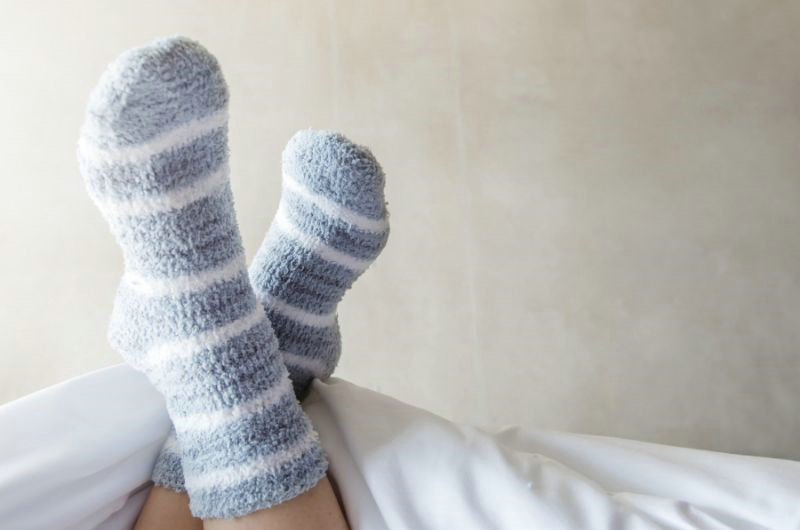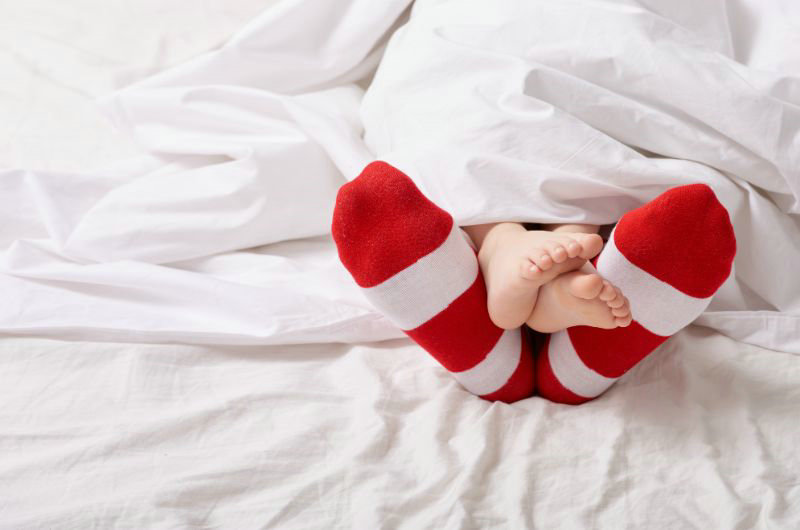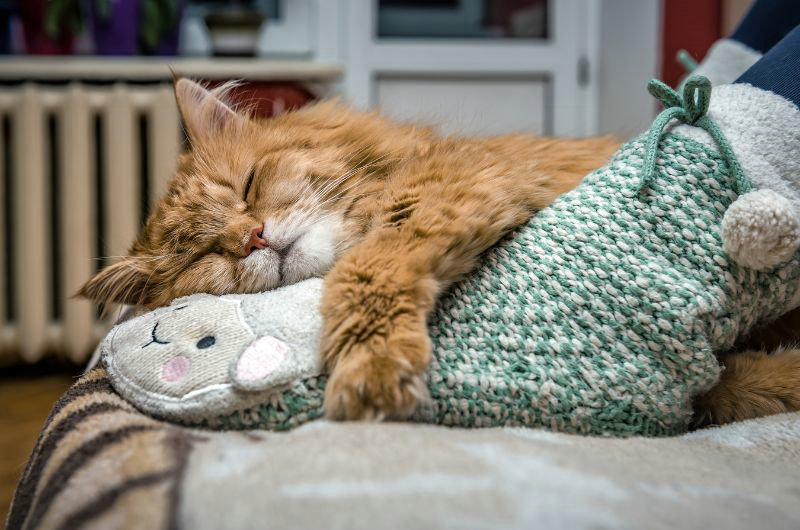
Key Takeaways
Yes. Sleeping with socks on does you good in two main aspects: first, it may help you fall asleep faster. Second, wearing socks to bed may improve your sleeping quality through efficient body temperature control. The warmth provided by socks contributes to blood circulation and may stimulate distal vasodilation, which is the dilation of blood vessels at the extremities of the body – an aspect that plays a crucial role in managing body temperature and sleep.
However, there also exist some potential risks and drawbacks concerning wearing socks to bed like sleeping hygiene and circulatory problems, which you should be aware of to get better sleeping quality.
Furthermore, we’ve concluded some details for sleeping with socks on. Please consider these points for optimal results:
- Material: Choose socks made from breathable, natural fibers to avoid overheating.
- Fit: Ensure socks aren’t restrictive, to promote circulation.
- Hygiene: Keep your bedtime socks clean to maintain good sleep hygiene.
The Health Benefits of Sleeping with Socks on

Fall asleep faster
Studies have found that people who wear socks to bed not only fall asleep faster, but also sleep longer and wake up fewer times during the night compared to those not wearing socks. One study showed that sock-wearers fell asleep 7.5 minutes faster, slept 32 minutes longer, and woke up 7.5 times less.
Wearing socks warms up your feet, which causes vasodilation – the dilation of blood vessels. This increases blood flow to the skin surface, resulting in heat loss that lowers your core body temperature. Since a slight drop in body temperature is a natural signal that it’s time for sleep, wearing socks can help you fall asleep faster.
Thermoregulation and Onset of Sleep
Our body’s core temperature follows a circadian rhythm, with the lowest point occurring in the early morning hours when we are typically asleep. As bedtime approaches, our core body temperature starts to drop, signaling to the brain that it’s time to sleep. This drop in core temperature is facilitated by increased blood flow and heat loss through the skin, especially in the hands and feet (distal regions). This process is known as distal vasodilation – the widening of blood vessels in the extremities. It helps maintain appropriate temperature for sleep by creating constant heat to help keep your feet warm and assist you in sleeping better.
Get better quality sleep
Increases sleep efficiency and duration
Not only do socks help you fall asleep quicker, but research shows they can also improve sleep efficiency (ratio of time spent asleep to total time in bed) and total sleep time. The same study found that wearing socks led to 32 minutes of extra sleep time and 7.6% higher sleep efficiency.
Reduces nighttime awakenings
Cold feet can cause discomfort and awakenings that fragment your sleep, which will lead to sleeping disorders or disrupt your sleeping cycle. Wearing socks prevents your feet from getting too cold, minimizing cold-related sleep disruptions and awakenings. One study reported that sock-wearers woke up 7.5 times less frequently during the night.
Promotes continuous, consolidated sleep
By facilitating faster sleep onset, increasing sleep duration, and preventing awakenings, wearing socks ultimately allows for more continuous and consolidated sleep throughout the night.
Prevent dry, cracked heels
Applying a thick, occlusive moisturizer or heel balm to your feet before bed is an effective way to replenish lost moisture. However, the moisturizer can get rubbed off or absorbed too quickly if your feet are left uncovered. Wearing socks after moisturizing creates a warm, humid environment that allows the moisturizing products to fully penetrate and hydrate the thick skin on your heels overnight.
The socks act as a physical barrier, preventing evaporation and locking the moisturizing ingredients against your skin for maximum absorption over an extended period of time while you sleep.
Prevent Raynaud’s attacks
Raynaud’s disease causes the small arteries in the hands and feet to narrow in response to cold, limiting blood flow. Wearing socks to bed keeps the feet warm and improves circulation, which can help prevent painful Raynaud’s attacks from being triggered.
Reduce hot flashes during menopause
Although it seems counterintuitive, wearing socks can actually help menopausal women reduce nighttime hot flashes. Warm feet cause vasodilation which helps regulate and stabilize core body temperature, minimizing sudden spikes that lead to hot flashes.
Potential Risks and Considerations

While considering whether to sleep with socks on, it’s also important to be aware of some potential risks and factors that may affect your decision to wear socks in bed.
- Hygiene: Wearing socks to bed without proper hygiene can lead to an increase in bacteria growth due to the warm, moist environment inside the socks. It’s crucial to wear a clean pair each night and maintain clean feet to minimize this risk.
- Bacteria Growth: Moisture trapped in socks can promote the proliferation of bacteria, potentially leading to foot infections. Breathable materials like cotton can mitigate this issue by allowing better airflow.
- Diabetes: People who have diabetes might have special considerations due to the disease’s effects on circulation and sensation in your feet. Consult a healthcare expert to determine if wearing socks at night is safe for you, as non-binding diabetic socks may be recommended.
- Circulatory Problems: Anyone with existing circulatory problems should pay attention to the type of socks worn to bed. Tight socks may exacerbate issues by restricting blood flow. Look for options that provide warmth without a tight fit.
It’s advisable to weigh these considerations in light of your own health and comfort needs. If you’re unsure, health professionals can offer personalized advice based on your specific circumstances.
Tips for Sleeping with Socks
When considering wearing socks to bed, your choice of material is vital. Socks made from natural fibers such as cotton, cashmere, or merino wool may enhance comfort due to their breathability and softness. These materials help maintain a balanced temperature, so your feet stay warm without overheating.
However, you should be mindful of the fit of your socks. Compression socks can be too tight for overnight wear and aren’t typically recommended unless otherwise advised for health reasons. Instead, you may want to opt for bed socks, which are designed specifically for sleep and usually provide a loose, cozy fit.
To help you fall asleep faster, the warmth from wearing socks might assist by dilating blood vessels in the feet, which in turn can signal the brain that it’s bedtime. Here’s how to optimize your nighttime sock-wearing experience:
- Choose a sock material that feels comfortable against your skin. If you tend to have cold feet, consider thicker materials like cashmere or merino wool. For those who get hot easily, cotton may be a better choice.
- Wear a pair that fits well — not too tight, to avoid restricting circulation, and not too loose, so they don’t come off during the night.
It’s essential that you pay attention to your personal preference and comfort. If you find yourself waking up in the middle of the night because of your socks, then consider adjusting the material or fit. Utilizing the tips above should help create the optimal conditions for a restful night’s sleep.
Sinoknit, Why Us?
Ningbo Sinoknit Co., Ltd. is a leading wholesale custom sock manufacturer located in Zhuji, China. Our headquarters is in Ningbo, one of China’s major ports. Since 2004, we’ve been specializing in producing various types of high-quality socks using cutting-edge materials such as 100% cotton, combed cotton, mercerized cotton, chemical fiber blended yarn, and lycra.
Our socks factory is equipped with over 300 computerized sock knitting machines imported from Italy and Korea. This allows us to produce up to 20 million pairs of socks per year. With an extensive range of over 100 sock varieties, we offer 96-needle, 108-needle, 120-needle, 132-needle, 144-needle, 168-needle, and 200-needle slim socks, terry socks, cotton-yarn socks, and woolen pants.
Our products are exported to more than 20 countries and regions, including Korea, Japan, Southeast Asia, the Middle East, Europe, and North America. Trust us to provide you with the best wholesale socks for your needs.



